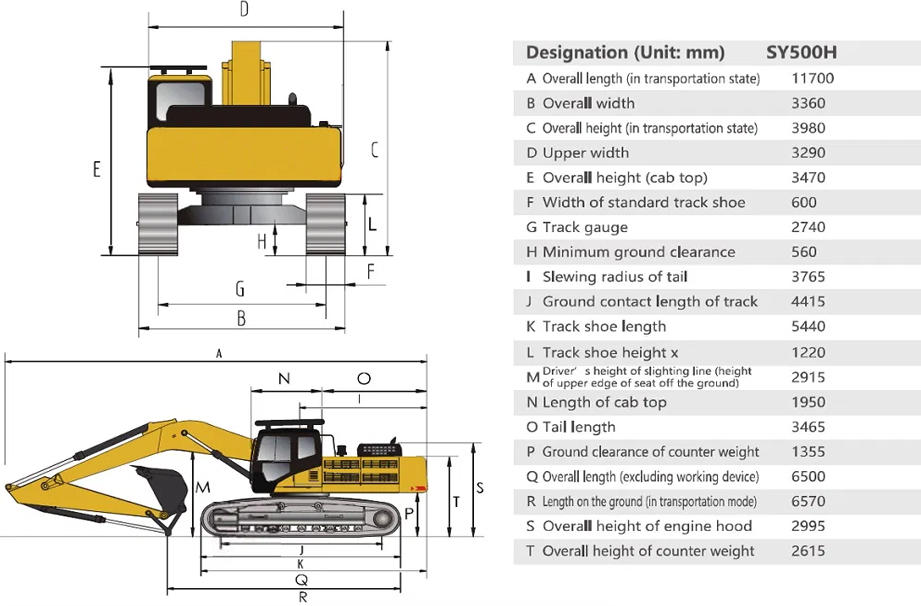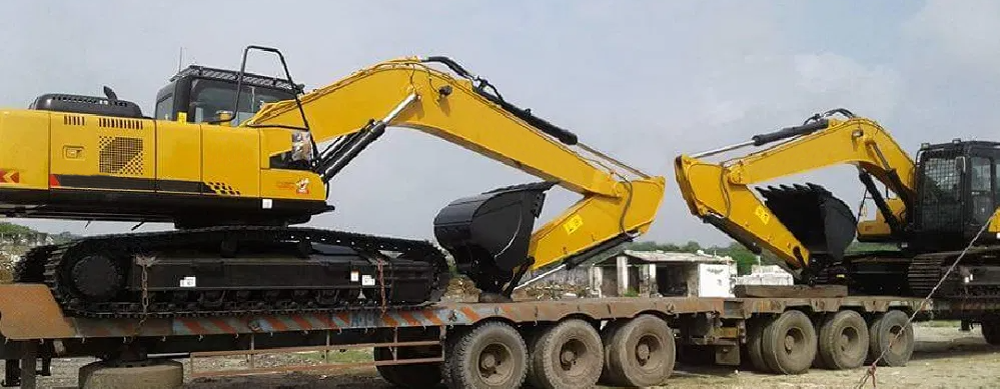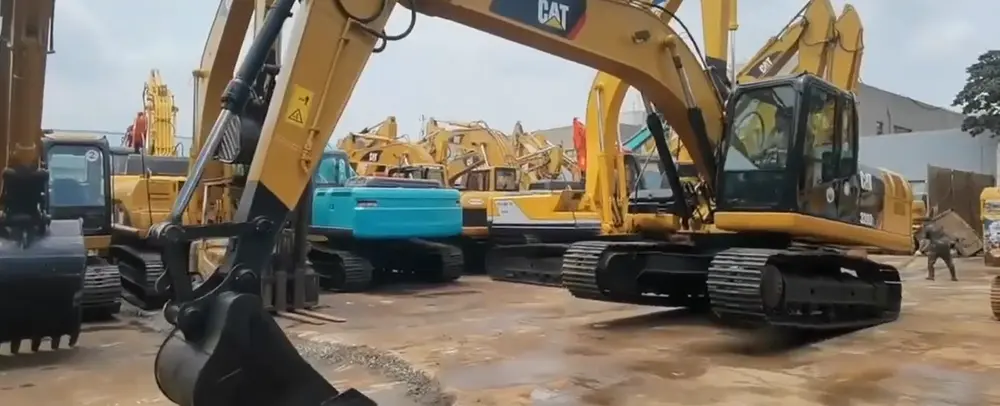Long-reach Excavators are specialized heavy machinery designed for unique and challenging tasks. These machines feature an elongated boom and arm system, allowing them to access areas that are otherwise difficult to reach. Built with a robust steel frame, they can withstand significant stress. Their powerful hydraulic systems precisely control the extended appendages, enabling precise digging and material handling at a distance. Equipped with a potent engine, they deliver the necessary force to operate efficiently. The operator's cab is engineered for comfort, providing good visibility and ergonomic controls, making them ideal for jobs like dredging, riverbank stabilization, and deep foundation work in confined spaces.
| Pictures |
|
|
|
|
|
| General parameters | |||||
| Model | SY750H | SY870H | SY870H-S | SY980H | SY1250H |
| Tonnage range | Over 50 tons | Over 50 tons | Over 50 tons | Over 50 tons | Over 50 tons |
| Travel mode | Crawler | Crawler | Crawler | Crawler | Crawler |
| Bucket type | Backhoe | Backhoe | Backhoe | Backhoe | Backhoe |
| Application | Mine type | Mine type | Mine type | Mine type | Mine type |
| Power Type | Fuel | Fuel | Fuel | Fuel | |
| Engine (fuel) | |||||
| Type | Direct injection, 6-cylinder, 4-stroke, turbocharged intercooled, water cooled | Direct injection, 6-cylinder, 4-stroke, turbocharged intercooled, water cooled | Direct injection, 6-cylinder, 4-stroke, turbocharged intercooled, water cooled | ||
| Rated power (kW) | 382 | 377 | 382 | 425 | 567 |
| Rated speed (r/min) | 1800 | 1800 | 1800 | 1800 | 1800 |
| Maximum torque (N·m) | 2250 | 2250/1300 | 2450 | ||
| Total Displacement (L) | 15.681 | 15.681 | 16 | ||
| Number of cylinders (pcs) | 6 | 6 | |||
| Emission standard | Euro 4 | Euro 4 | |||
| Performance Parameters | |||||
| Operating weight (kg) | 76000 | 78600 | 78600 | 95800 | 125000 |
| Bucket capacity (m³) | 5.0 | 5.0/5.4 | 5.4 | 5.5~8.0 | 7.0-10.0 |
| Travel speed (high/low) (km/h) | 4.5/2.9 | 4.5/2.9 | 4.5/2.9 | 3.4/2.3 | 3.5/2.4 |
| Rotation speed (rpm) | 7.2 | 7.7 | 7.2 | 7 | 5.5 |
| Ground Specific Pressure (Kpa) | 112 | 114 | 112 | 132 | 150 |
| Climbing capacity (%) | 70 | 70 | 35 | 70 | 70 |
| Bucket digging force (kN) | 390 | 432 | 430 | 480 | 605 |
| Movable arm length (mm) | 7000 | 7250 | |||
| Bucket Length (mm) | 2800 | 2920 | |||
| Maximum Traction Force (kN) | 547 | ||||
| Dimension | |||||
| L x W x H (transportation condition) (mm) | 13152×4030/3430×5100 | 13002×4320×4742 | 13840×3700×5300 | 14710×5560×6260 | |
| Cab height (mm) | 3872 | 3880 | |||
| Track Ground Length (mm) | 4650 | 4770 | 5070 | 5150 | |
| Overall track length (mm) | 5858 | 5946 | 6350 | 6630 | |
| Track plate width (mm) | 650 | 650 | 650 | 650 | 700 |
| Track gauge (mm) | 3380/2780 | 3380/2780 | 2750/3510 | 3900 | |
| Minimum Ground Clearance (mm) | 892 | 880 | 945 | 1085 | |
| Minimum Turning Radius (Front End Unit) (mm) | 5620 | 5010 | 6550 | ||
| Rear Swing Radius (mm) | 4175 | 4220 | 4700 | 4950 | |
| Scope of operation | |||||
| Maximum digging radius (mm) | 11986 | 12280 | 13335 | ||
| Maximum digging depth (mm) | 7425 | 6740 | 8065 | ||
| Maximum digging height (mm) | 11052 | 12310 | 12550 | ||
| Maximum unloading height (mm) | 7051 | 8345 | 7945 | ||
| Maximum vertical digging depth (mm) | 7067 | 4250 | 5085 | ||
| Fuel Volume | |||||
| Fuel tank (L) | 950 | 950 | 1180 | ||
| Hydraulic oil tank (L) | 680 | ||||
| Engine Oil Change (L) | 42~57 | 42~57 | 50 |

Long-reach excavator frames and components are engineered for extended operations. The frame, typically made of high-strength steel, provides a stable base and withstands the stress of reaching far distances. Key components include:
Boom: The long, horizontal arm that extends from the machine's base. It's designed to bear heavy loads and reach far-out areas, often made of durable steel alloys and may be telescopic for adjustable reach .
Arm/Stick: Attaches to the end of the boom and supports the bucket. It provides additional reach and flexibility in movement, enabling precise digging and material handling at a distance .
Bucket: The scoop-like attachment at the end for excavating and moving materials. Comes in various sizes and types, such as general-purpose, rock, or dredging buckets, depending on the application .
Hydraulic Cylinders: Power the movements of the boom, arm, and bucket. They work by pressurizing hydraulic fluid to move pistons, providing the force needed for smooth and precise operations .
Hoses and Valves: Control the flow and direction of hydraulic fluid, ensuring proper coordination of component movements. High-quality hoses and valves are crucial for efficient and reliable operation .
Undercarriage: Consists of tracks, track frame, pads, chains, shoes, bolts, sprockets, rollers, and idlers. The tracks and track frame distribute the machine's weight, providing stability and mobility, while other components ensure smooth track movement and protect against wear and tear.

1. Digging Depth and Reach: Determine the required digging depth and reach based on the specific project, such as deep foundation pits or dredging work. Standard long-reach excavators may have a reach of 10-18 meters, while deep ones can reach 20-30 meters.
2. Load Capacity: Consider the weight of the materials to be lifted and moved. For heavy lifting tasks, an excavator with a heavier front end and greater load capacity is needed.
3. Boom and Arm Length: Longer boom and arm combinations provide greater reach but may sacrifice some digging force.
4. Engine Power: Adequate engine power is essential for efficient operation. It affects the digging speed and the ability to handle tough materials.
5. Bucket Capacity: Select the bucket capacity according to the volume of material to be excavated and transported.
6. Terrain and Ground Conditions: For rough or uneven terrain, a crawler-type long-reach excavator is more stable.
7. Build Quality: Inspect the construction quality of the excavator, including the strength of the frame, the quality of the welding, and the reliability of the components.
8. After-sales Service: Good after-sales service is crucial for minimizing downtime. Check the availability of local service centers, the response time of technicians, and the availability of spare parts.

The most prominent feature of a long-reach excavator is its remarkable reach. The elongated boom and arm combination allows it to access areas that are far from the machine's base.
Despite the long reach, these excavators are designed to provide precise control. The hydraulic system is fine-tuned to ensure that the movements of the boom, arm, and bucket are accurate even at a distance.
A powerful hydraulic system is at the heart of a long-reach excavator's operation. The system has to work against the leverage forces created by the long boom and arm.
Long-reach excavators can be equipped with a variety of buckets to suit different applications. There are general-purpose buckets for basic soil excavation and transportation, rock buckets with stronger teeth and more durable construction for handling rocky materials, and specialized buckets like dredging buckets.
To support the long reach and heavy-duty operations, these excavators have a stable and robust frame. The chassis is usually made of high-strength steel to withstand the forces exerted during operation.
The operator's cab is designed with the comfort and functionality of the operator in mind. It provides a good view of the work area, which is especially important given the long reach of the machine.

